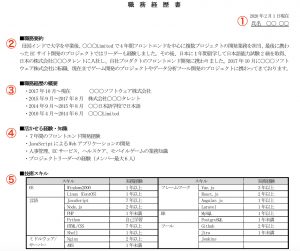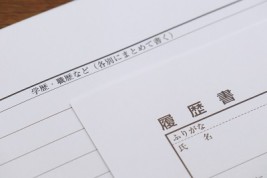If you would like to learn how to write a Japanese CV in Japanese, please click Here!
In this page, our firm G Talent, specialized in foreign IT engineer’s recruitment, prepared a Japanese CV sample that can be downloaded for foreign IT engineers who are thinking of changing jobs and we will explain how to create it.

Contents
Two Documents Required for Job-hunting: Japanese Resume “Rirekisho” & Japanese CV “Shokumu-keirekisho”
When applying for a job in Japan, you will generally need two documents: a Japanese Resume “Rirekisho” and a Japanese CV “Shokumu-keirekisho”.
- Japanese Resume (Rirekisho) – Document that conveys your background (education, work experience) and basic information (name, date of birth, contact information, etc.)
- Japanese CV (Shokumu-keirekisho) – Document that appeals to the past work experience (company you worked at, job description, skills you used, etc.)
On this page, we will guide you to download the Japanese CV sample and how to create your own. The first thing you need to clear before you start job hunting is to create a Japanese CV.
Your CV will determine whether you can pass the documents screening and get an interview. Therefore, it has to be easy to understand and the content should promote your skills.
It may seem a little difficult, but if you understand how to write it, you can easily create it, so let’s look back on your experience and skills you have learned!
※Please click on the following page to see how to make a Japanese resume.
Japanese CV “Shokumu-keirekisho” Sample for Download
First, download the sample of the Japanese CV “Shokumu-keirekisho” from the button below.
Download Template職務経歴書(Template with English guidance).docx
※ Available in Microsoft Excel format.
When the download is complete, open the file.
From now on, we will guide you through on how to write your CV according to the sample.

How to Write the Japanese CV “Shokumu-keirekisho” for IT Engineers
The purpose of submitting your Japanese CV is to get the company interested in your work experience and to get the chance of an interview.
To achieve that goal, let’s first understand the four key points to create a great Japanese CV.
< Key Points >
- Fill in with the specific job description. (Avoid abstract content)
- Specify your achievements (Appeal with your strengths)
- Choose an easy-to-understand layout (Make it easy for companies to read it)
- Make sure there are no mistakes when filling it (especially make sure there are no mistakes on the period of employment!)
And, if you want to create your CV based on the sample you have downloaded this time, it will be divided in the following eight key elements.
< 8 Key Elements of a Japanese CV >
- Name and Submission date
- Professional Summary
- Summary of work experience
- Summary of experience and knowledge
- Technical skills
- Professional background (work experience)
- Certifications/Licenses
- Personal summary (self-PR)

Next, we will describe these eight elements in detail.
1~5 (from Name to Technical skills)
First, we will explain the following 1~5 points.
1.Name and submission Date
Enter your name and the creation date in the upper right corner.
Please fill in the date in which you will submit your Japanese CV.
※Always be careful to update every time to a new date.
Companies want the most up-to-date information, so if the date is more than three months old, please correct it to a new date.
2.Professional summary
Please fill out your previous work experience with simple sentences.
The first thing that the company’s HR looks at is the professional summary, this part will help them to visualize your past work experience.
3.Summary of work experience
Fill in all the companies you have worked for, from the newest company (the company you were last enrolled) and in order, enter the employment dates and the official company name.
※In case of Japanese Resume, the companies are listed in order from the oldest company. However, in the Japanese CV, since the experience and skills are the ones that should be appealing, it’s important to write them in a different order, which should be from the most recent job description.
If there is a period during which you were not enrolled in a company, due to studying abroad, please also indicate this. If you have not been with a company for a long period, it can give a bad impression to the company’s HR.
So, if there is a blank period, be sure to enter it here.
4.Summary of experience and knowledge
Be sure to enter what you want to make an impact with, like the experience and knowledge you have gained from your previous work experience.
For example, if you have an experience that you want to make stand out, be specific not only in the type of job that you experienced, but also by including the number of years. Furthermore, by including the programming languages that you are good at in your development experience, it will make clear on what kind of languages you are good at developing.
5.Technical Skills
If you are an IT engineer, you need to clearly communicate how much practical work experience you have, such as operating systems, languages, frameworks, middleware, and tools. As well, enter the working level to properly convey your skills to the companies that you will apply to.
Languages and frameworks that you have no experience with and learned on your own should be labeled as “self-learning.”

6.Professional background (work experience)
We will continue to explain the element 6.
6.Professional background (work experience)
The work experience is the most important part. We will describe each entry and all the important points to write it below.
#1. Please fill in each company you have worked at
Fill in the following items, so when the company you applied for reads your Work History, they can understand the past company’s business, size, what department you belong to, and how long you have been working.
Additionally, same as in the “Summary of work experience”, fill in all the companies you have worked for, from the newest company (the company you were last enrolled) to the oldest.
- Company name (Official name)
- Employment Period (Date of joining- Date of retirement)
- Company’s Business and number of employees
- Department
#2. Enter the job description and projects you were involved at the company
Fill out the following items so when the company you applied looks at your Job History, they can understand what kind of system development, role, and the results you have been achieved at the company.
Then, please enter separated each project. If it is not a project-based job, please enter and separate each role or product you were involved with.
- Project period (Period in each role)
- Project overview (Easy to understand)
- Description of the work within the project (Easy to understand with bullet points, etc.)
- The results you have achieved in the project
- Development phase of the project that you were in charge (design, development, testing, etc.)
- Environment used in the project (programming language, framework, OS, DB, etc.)
- Project size and your role
Regarding the achievements, please indicate your contributions to the project.
Please try to enter not only big accomplishments, but also small achievements, like, whether the project was completed without any problems, if the system’s performance or efficiency was improved or if the efficiency of the surrounding members was improved.
By entering your achievements, you will also be able to show the company that you are applying, a high level of commitment to the results.

7.Certifications/Licenses & 8.Personal Summary (self-PR)
Finally, we will explain the following points.
7.Certifications
Enter the qualifications that can be appealing to the company.
IT related certificates and language certificates will be appealing from a practical perspective.
8.Personal Summary (self-PR)
At this point, since the self-promotion has already been done with the previous elements, there is no problem in filling it with simple contents. Write down how your skills, experience, and abilities can contribute to the company you are applying to.
If you are highly motivated to join the company you are applying for, it may be a good idea to fill in the reason to join the company and your motivation, rather than your own self-summary.

Conclusion
We presented above an effective method for creating a Japanese CV “Shokumu-keirekisho” for foreign IT engineers in Japan. Be sure to be prepared when you start job hunting, since the chances of going to an interview will increase when submitting a Japanese CV.
If you are a foreign IT engineer working in Japan and need advice on your Japanese Resume or Japanese CV, please use G Talent, a recruitment agent specialized in foreign IT engineers.










